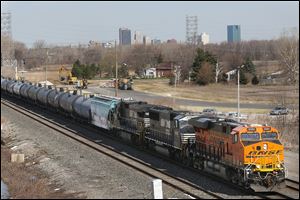
Rail safety experts look at oil, ethanol transport
Re-routing discussed at Washington forum
4/22/2014
A train transporting ethanol passes through Northwood with the skyline of downtown Toledo in the distance.
The public-safety benefit from routing trains hauling crude oil or ethanol to avoid heavily populated areas could be offset by the higher risk of derailments on lesser-used tracks, a panelist at a National Transportation Safety Board rail safety forum said Tuesday.
Higher-density railroad lines have lower derailment rates, and “traffic density tends to go to populated areas,” Christopher Barkan, executive director of the railroad engineering program at the University of Illinois, told the safety board’s forum on crude-oil and ethanol transport during the first of two days of panel discussions at NTSB headquarters in Washington.
“You’re exposing the populace along lower density lines to that traffic” if it is rerouted, he said, and that is “a nontrivial trade-off.”
The safety board is holding the forum Tuesday and today in response to a boom in railroad transport of ethanol and crude oil during the past 10 and five years, respectively, during which several high-profile train derailments have occurred.
Among the accidents cited was a Feb. 6, 2011, derailment on a Norfolk Southern track near Arcadia, Ohio, of 33 ethanol-laden tank cars that burst into flames, causing 20 nearby residents to be evacuated for most of a day.
More recently, several trains carrying oil from North Dakota’s Bakken oilfields to unloading facilities near the Gulf Coast or in Atlantic Canada derailed catastrophically, including a wreck last July 6 in Lac-Megantic, Que., that killed 47 people.
The oil-train derailments, in particular, have called into question standard railroad tank cars’ adequacy to carry highly flammable hazardous materials safely.
While such tank cars also carry other dangerous goods, oil and ethanol have become a focal point because of their growing movement in solid trains of about 80 to 100 cars.
Ethanol transport grew rapidly during the late 2000s because of its growing use as a pollution-control additive in gasoline, while railroads’ crude-oil traffic has boomed since 2008 with North Dakota’s oilfields because few pipelines are available there to ship product to refiners.
The lower Great Lakes region is astride major rail routes for both types of traffic between the Midwest and Eastern Seaboard. Trains hauling oil and ethanol pass through Toledo and other area cities nearly every day.
During a discussion Tuesday on tank-car design and related safety issues, panelists from the Association of American Railroads and a tank-car manufacturers’ group said they agreed on certain modifications to new tank-car designs in response to the earliest of the ethanol-train derailments, but need regulatory guidance for issues upon which they could not agree.
Those issues include the extent to which older tank cars will need safety upgrades to remain in ethanol or oil service and how thick the steel walls should be for new ethanol-service cars, they said.
Lee Johnson, a rail-logistics adviser for Hess Corp. representing the American Petroleum Institute at the forum, said it’s likely those older tank cars will be around for a while, because even though car-builders have ramped up production in recent years, the booming Bakken traffic is soaking up that capacity.
Retrofits could be a problem, he added, because there is little repair-shop space for such work and its temporary nature may make firms reluctant to invest in facilities for it.
Deborah A.P. Hersman, the safety board’s chairman, said those remarks created “not much cause for optimism” that the older tanks, which lack insulation that could keep their contents from rapidly overheating in a fire and have external fittings vulnerable to being knocked loose in an accident, will be retired or repurposed soon.
Speakers during a rail-operations discussion, meanwhile, said that besides improving tank-car designs to minimize accidents’ consequences, railroads need to do more to prevent derailments, especially those caused by rail defects.
A broken rail was blamed for the Arcadia train derailment, and Mr. Barkan said rail breaks or failed welds are by far the most common cause of derailments on main line tracks.
Anand Prabhakaran, vice president of engineering for Sharma & Associates Inc., said research his firm has done under a Federal Railroad Administration contract shows both lower speeds and stronger tank cars can reduce the number of cars punctured in a derailment.
The replacement of traditional air-pressure brakes with electronically controlled brakes could reduce accidents’ severity, Mr. Prabhakaran said, because the latter system applies brakes sooner and thus slows trains down faster in emergencies.
Emergency response to accidents and discussion of issues raised during the earlier sessions are planned when the forum concludes today. It is available for public viewing on the safety board’s Web site, ntsb.gov.
Contact David Patch at: dpatch@theblade.com or 419-724-6094.